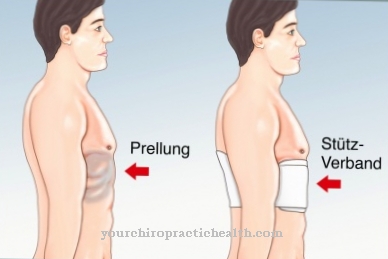Of the Waldenström's disease, also under the name Waldenström's macroglobulinemia known, belongs to the leukemia, more precisely to the lymphoma. The slowly progressing disease is rather rare and mostly affects elderly patients; patients under 40 are only affected in exceptional cases.
What is Waldenström's disease?

© L.Darin - stock.adobe.com
The Macroglobulinaemia Waldenström is a malignant disease of the white blood cells named after the Swedish doctor Jan Waldenström. He described the disease for the first time in the 1940s.
At the Waldenström's disease there is an uncontrolled increase in the B-lymphocytes, which belong to the white blood cells, the leukocytes. This creates a large number of, but dysfunctional, B lymphocytes. B lymphocytes play an important role in the immune system. They are responsible for the production of antibodies called immunoglobulins. The disturbed B lymphocytes in Waldenström's disease produce one of these immunoglobulins, immunoglobulin M (IgM), in large quantities.
However, this IgM produced by the degenerate cells has no function. In this case, one speaks of a paraprotein and, when there is an increased occurrence of paraproteins in the blood, of paraproteinemia. B lymphocytes, like most other blood cells, are made in the bone marrow. Since an abnormally high number of B-lymphocytes are formed in Waldenström's disease, they infiltrate the bone marrow and displace the stem cells from which the other blood cells are formed. The degenerated B lymphocytes can also infiltrate other organs such as the spleen, lymph nodes or the liver.
causes
Waldenström's disease is a rare disease. It occurs about once per 100,000 inhabitants per year in Germany. Most patients are over 60 years old at the time of diagnosis, and Waldenström's disease is rarely diagnosed in patients who are younger than 40 years.
As with most forms of leukemia, the cause of Waldenström's macroglobulinemia is still unclear. However, various triggering factors are discussed. Scientists assume that various chemicals, especially benzene, can lead to disorders in blood formation. The same goes for cytotoxic drugs. It is not uncommon for tumor patients to develop leukemia after treatment with cytostatic drugs. Something similar is observed with ionizing radiation. In medicine, ionizing radiation is used, for example, in x-rays or in radiation therapy in cancer treatment.
Viruses are also suspected to play an important role in the development of leukemia and tumors. Hepatitis B and C viruses, human papilloma viruses and the Epstein-Barr virus should be mentioned here. A genetic predisposition and psychogenic factors are also discussed as triggers or causes for leukemia.
Symptoms, ailments & signs
Waldenström's disease often goes undetected and is usually a chance diagnosis during routine blood tests. The symptoms of the disease are caused on the one hand by the infiltration of the bone marrow and organs and on the other hand by paraproteinemia.
By infiltrating the bone marrow, the production of other blood cells is severely restricted. The lack of red blood cells leads to anemia with the typical symptoms of anemia such as extreme tiredness, paleness, shivering, difficulty concentrating, headache or dizziness. Platelets are also no longer sufficiently produced. Platelets are platelets and an important part of blood clotting.
If there are too few platelets in the blood, as in Waldenström's disease, there is an increased tendency to bleed. This shows up, for example, in frequent nosebleeds or the increased occurrence of bruises. In Waldenström's disease, immunoglobulins are produced, but they have no function. There is a lack of functioning antibodies. The result is an increased susceptibility to infection. About two thirds of all Waldenström's disease patients complain of polyneuropathies, i.e. sensory disorders such as tingling, burning, pins and needles or lack of awareness in the extremities.
This is caused by the impaired immunoglobulins that settle in the nerves. The immunoglobulins can also cause swelling of the liver, swelling of the lymph nodes or punctate skin hemorrhages. The overproduction of paraproteins also thickens the blood so that it can no longer flow as quickly. This manifests itself among other things in unspecific symptoms such as weakness, tiredness or loss of appetite. Loss of vision or hearing can also be caused by this so-called hyperviscosity syndrome.
Diagnosis & course of disease
The diagnosis of Waldenström's disease is made through various laboratory, genetic and immunological tests. The abnormal and greatly increased immunoglobulin M is detected in the laboratory using protein electrophoresis. A bone marrow puncture is performed, the bone marrow aspirate showing a strong increase in B lymphocytes. These lymphocytes also have a special genetic mutation. To determine the extent of the infiltration in the body, imaging methods such as computed tomography or magnetic resonance tomography are used.
The disease progresses slowly without treatment. With treatment, the mean survival time is 7.7 years, which means that half of all patients have died within this time from the diagnosis.
Complications
In most cases, Waldenström's disease is only diagnosed through a random examination, so early treatment is usually not possible. Those affected suffer from pronounced anemia and thus also from tiredness and paleness. The resilience of the person affected is also significantly reduced by the complaints and fatigue occurs.
The patients also suffer from concentration disorders and severe dizziness. Headaches develop, and these complaints can affect the development of children in particular. The patient's quality of life is significantly reduced by Waldenström's disease. It is not uncommon for those affected to suffer from nosebleeds and paralysis or other sensory disorders.
Bleeding from the skin or a loss of appetite can also occur and continue to restrict the everyday life of the person concerned. A causal therapy for Waldenström's disease is unfortunately not possible. The symptoms can, however, be limited relatively well with the help of medication. There are no complications and the disease always progresses positively. Life expectancy is usually not reduced or restricted with successful treatment.
When should you go to the doctor?
If the feeling of illness persists or increases, a doctor should be consulted. If there is a diffuse malaise, an inner restlessness or a loss of well-being, a doctor's visit is advisable. Since the disease is usually only discovered by chance, special attention must be paid to physical changes and impairments in coping with everyday life. The risk group for Waldenström's disease includes women over 40 years of age. In particular, you should consult a doctor in the event of irregularities or changes. If you experience sleep disorders, headaches, or a decrease in mental or physical performance, there is cause for concern.
In the case of disorders of concentration and attention, dizziness or vomiting, the symptoms must be clarified. The formation of bruises or other skin changes, a sudden tendency to bleed as well as irregular menstrual cycles should be discussed with a doctor. Fatigue, fatigue and rapid fatigue indicate health disorders and should be examined.
If the tendency to infections increases, if there are sensitivity disorders on the skin, numbness or a tingling sensation on the body, a doctor is required. Pale appearance, blood flow problems, or changes in heart rhythm are causes for concern. If the symptoms persist for several weeks, a doctor should be consulted.
Therapy & Treatment
Therapy is only given when the disease causes symptoms. The goal of therapy in Waldenström's disease is not to cure the disease, but to eliminate or alleviate the symptoms. One speaks here of a palliative therapy approach. A combination of cytostatics and cortisone is used.
If there are a lot of IgM in the blood and thus impair the flow properties of the blood, plasmapheresis can also be carried out. The blood plasma and thus the paraproteins contained in it are exchanged with a plasmapheresis device.
Outlook & forecast
If left untreated, Waldenström's disease progresses slowly. Since there are too few functioning leukocytes in the body, an antibody deficiency syndrome occurs, which is associated with a weak immune system and an increased risk of infection. With contemporary therapy, the mean survival time is 7 to 8 years after the initial diagnosis. However, some of those affected still live for over 20 years with a high quality of life.
The individual prognosis depends on various factors. The prognosis depends on which risk group the sick person belongs to. In high-risk patients, the 5-year survival rate averages 36 percent, in low-risk patients it is 87 percent. According to the prognosis index of the International Scoring System for Waldenström's Macroglobulinemia (ISSWM), parameters with a negative influence on the prognosis are an age over 65 years, a lowered hemoglobin value (below 11.5 g / dl), a severely lowered platelet count ( below 100,000 / µl), an increased monoclonal protein concentration (over 70 g / l) and an increased beta-2-microglobulin blood level (over 3 mg / l).
In many of those affected before the age of 65, the disease can be regressed in the long term through therapy. Finally, the therapy is continuously expanded and improved with new drugs (including tyrosine kinase inhibitors, rituximab). Therefore, experts assume that the forecast will improve significantly in the future.
Prevent
Since the causes of Waldenström's disease are still not sufficiently understood, there are no preventive measures against the disease. To reduce the risk of illness, contact with chemical pollutants such as benzene should be avoided. You should also avoid unnecessary radiation exposure, for example through increased x-ray examinations.
Aftercare
In most cases, the follow-up measures for Waldenström's disease are relatively limited or are not even available to the person affected. Therefore, ideally, a doctor should be consulted at the first symptoms and signs of the disease so that there are no further complaints or complications. Self-healing cannot occur.
Since it is a genetic disease, if the person concerned wants to have a child, they should have a genetic test carried out in order to prevent Waldenström's disease from occurring again. Those affected are usually dependent on long-term treatment, although complete healing cannot be achieved.
In their everyday life, patients are therefore also dependent on the support and help of their own family and friends and acquaintances. This can also prevent psychological complaints or depression. Not infrequently, with Waldenström's disease, contact with other patients with the disease can also be very useful. This often leads to an exchange of information, which can make everyday life easier for the person concerned. The disease may limit the life expectancy of the person affected.
You can do that yourself
Waldenström's disease is a very rare disease that must first be clarified and treated by a doctor. You can take action yourself against the consequences of an infiltration of the bone marrow. Those affected should also take measures to reduce the emotional stress associated with the disease.
In addition to medical physiotherapy, physiotherapy or yoga can be performed. Physical exercises help strengthen the musculoskeletal system and relieve pain. However, sufficient rest and relaxation are also important. This is the only way to ensure that the symptoms do not worsen. If the main symptoms are accompanied by a hyperviscosity syndrome, drug treatment is necessary. The patient can support this by noting any side effects and interactions in a complaint diary and communicating the results to the doctor.
Finally, with Waldenström's disease, therapeutic help must always be sought. For example, patients can visit a self-help group and talk to other people affected. Sick people can also find support and information in internet forums or in specialist centers for relevant diseases. All measures should be taken in consultation with the responsible orthopedic surgeon or internist.













.jpg)

.jpg)
.jpg)











.jpg)